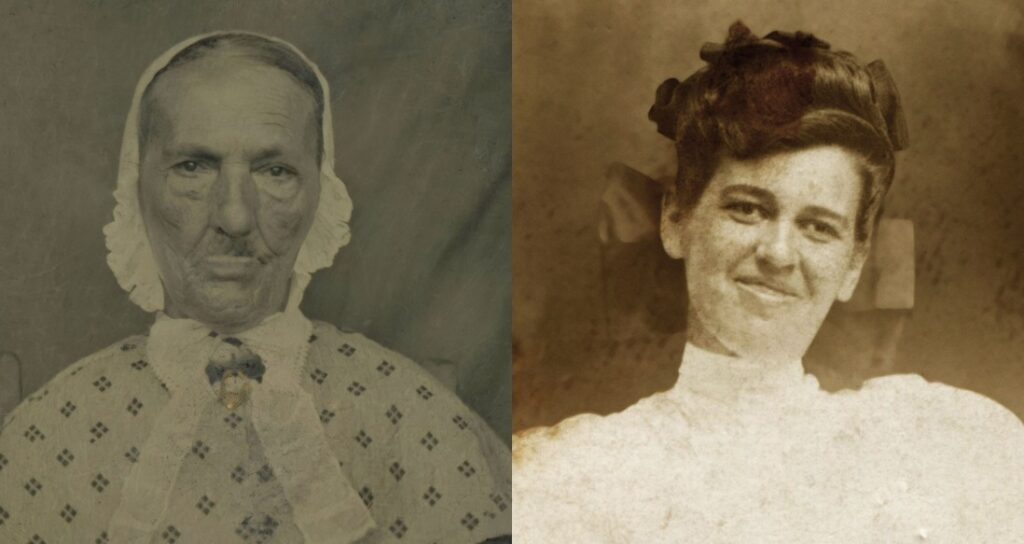
**This research was first published in the July 31, 2024 edition of the Chatham Star-Tribune newspaper as part of Kyle Griffith’s weekly segment entitled “Heritage Highlights.”

A comparison of the common resting face from an 1870s formal tintype portrait (unknown lady)
and a more casual 1910s penny portrait featuring a smile (Ida Pruett of Pittsylvania County).
When looking through photographs from the 1800s the serious glares, unsmiling faces, and stiff poses may appear odd from the modern perspective. Unlike today, where smiling is very common in pictures, wide grins were rarely captured in studio portraits over a century ago. Understanding the reasons behind this requires looking into the technology and cultural beliefs of the past.
In rural Southside Virginia, the introduction of photography was gradual throughout the nineteenth century. Not every community had immediate access to a photographer. Traveling photographers often set up temporary studios or worked out of wagons, making portraits accessible during community events, fairs, or market days. Alternatively, families might travel to the nearest town to have their portraits taken in a studio.
For many individuals, especially older people during the 1840s and 1850s, having a photograph taken might be a once-in-a-lifetime event. However, some people were reluctant to have their photo taken due to an uncertainty of new technology or conflicts of religious beliefs. Additionally, there was a superstition that taking a photograph could capture or harm a person’s soul.
Preparing for a photographic portrait was a serious occasion and a relatively expensive investment. People wore their best clothing. It was akin to having a painted portrait made, which was meant to capture one’s true likeness and convey a sense of dignity and respectability. The cultural etiquette for formal portraits at the time did not emphasize smiling and it would have been considered informal or strange to appear in an image with a toothy grin.
Different photographic technologies also played a role in the way people were portrayed. A common misconception is that all old photographic processes required extremely long exposure times, making it difficult for subjects to hold a smile. The first widely-available form of photography, called daguerreotypes, did require long exposure times. By the 1850’s, it took only about sixty to ninety seconds of exposure depending on the lighting. This was a great improvement from the very first experiments in photography during the 1820s, which were exposed for hours or days, making it impossible to capture images of people or moving objects until years later. Glass plate negatives and ferrotypes (tintypes) became prevalent throughout the 1860s, 1870s, and 1880s. They were much more affordable with shorter exposure times, but still not instant or cheap. Even with shorter exposure times of a few seconds, holding a smile was enough to make someone appear blurrier compared to maintaining a neutral expression. It’s hard to imagine what face to make as the subject stands against a backdrop, a posing stand steadying their neck, and the photographer removes the lens cap from his wooden box camera to capture a likeness. After a few seconds, the lens cap was placed back on and the exposure was complete. There was no button, shutter, or sound to the process. The photographer removed his plate back to the darkroom to develop it with the skills of a chemist. While rare, there are plenty of surviving nineteenth century photographs that show people smiling.
After the turn of the twentieth century, forms of black and white roll film photography became steadily available to the general public. Personal cameras allowed for instant snapshot photography that revealed the informal and candid sides of life. A prime example was the Kodak Brownie camera, which was priced at one dollar when it was introduced in 1908. In addition, the popularity of penny pictures in the early 20th century further informalized photography. Within these inexpensive, photo booth-style strips people were encouraged to make spontaneous and fun expressions, including smiling, laughing, and hugging. This shift contributed to the cultural acceptance of smiling in photographs, making it a more common feature in everyday snapshots.
Through the filters of old time, archaic technology, and outdated social practices, the people of the past may seem alien or fictional. Yet, they were humans who smiled, had personalities, and sometimes lived very long and complex lives. In the modern era, there are more photographs taken every single day than the total number of photos taken during the 1800s. The nearly infinite storage and instant accessibility of digital cameras has made smiling in photographs common and expected.
